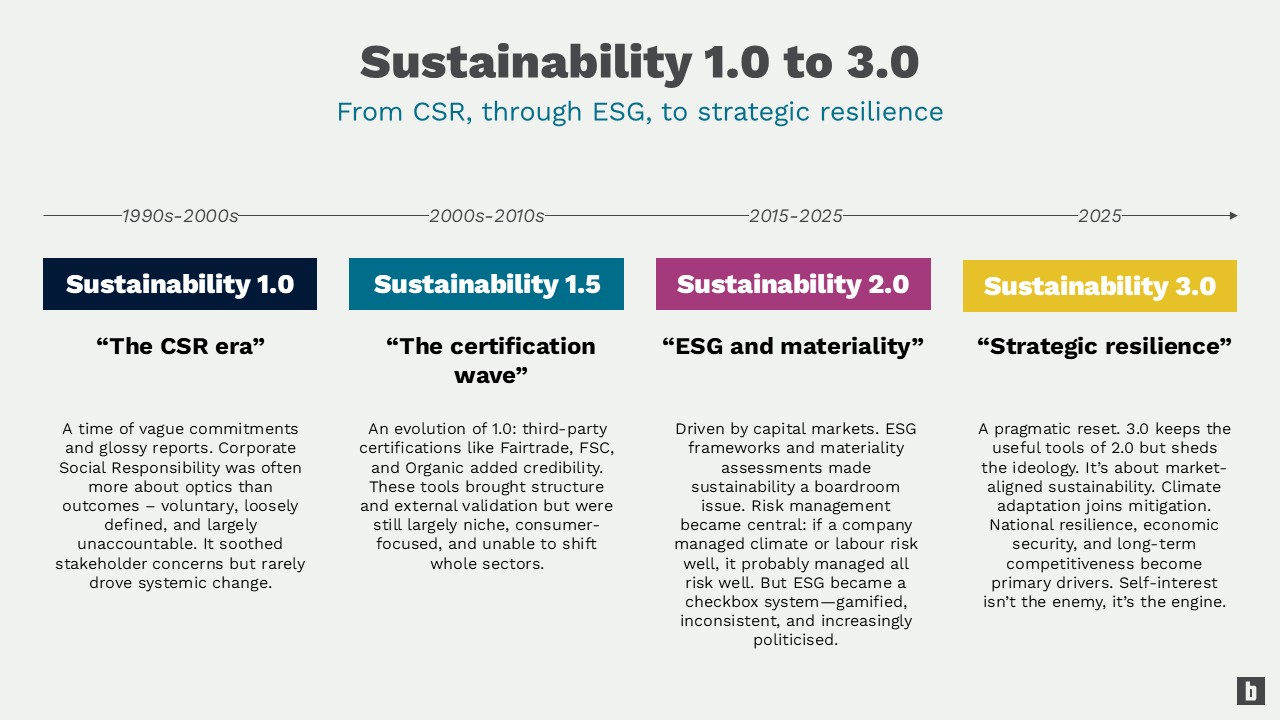The blog below forms an introduction to what will be an informal series of opinion and insight over the coming weeks around what we’re calling ‘Sustainability 3.0’, a new and necessary era of pragmatic sustainability action and communication.
The sustainability movement has never been static. From its early roots in corporate social responsibility to the emergence of ESG as a dominant investing lens, each era has reshaped how businesses think about their relationship with people, planet, and profit. Today, we stand on the threshold of a new era – Sustainability 3.0 – and it needs to be the most consequential yet.
Sustainability 1.0, spanning the 1990s to early 2000s, was the age of CSR: a well-intentioned but often superficial effort to signal virtue. Vague promises, glossy reports, and community initiatives dominated, but rarely disrupted business as usual. This phase was sharpened somewhat by an interim phase (let’s call it Sustainability 1.5), in which third-party certifications emerged (e.g. Fairtrade, FSC, Organic) that added a lot more integrity but haven’t quite scaled enough beyond being a relatively niche consumer choice to drive systemic change.
Sustainability 2.0 was defined by ESG and materiality. From 2015 onwards, sustainability moved into the language of capital markets. Institutional investors and asset managers recognized that how a company managed environmental and social risk was a proxy for overall governance. ESG scores became financial tools. Blurred itself was born into this era, and because of the rampant greenwashing we argued – and still do – that ESG and Purpose are a continuum, which we called ESGP, and that you cannot credibly claim to ‘do good’ until you have proved you ‘do no harm.’ We launched the Impact Gap methodology to measure the disconnect between these agendas within companies. Sustainability went from the margins to the boardroom. But it wasn’t perfect. The very frameworks that made ESG investable also made it gameable. Greenwashing evolved. ESG became politicised. And progress began to stall under the weight of its own contradictions.
Now, as we confront a decade marked by polycrisis – climate disruption, geopolitical volatility, wars, inflation – Sustainability 3.0 is emerging. It is a pragmatic reset, less about moral crusades and more about market-aligned resilience. It is and will be a practical, needs-must response to populist, Trumpian times, where grounding your argument in measurable impact on people, rather than abstract impact on ‘planet’, and aligning it with the governmental priorities of national resilience and growth is critical.
Sustainability 3.0 keeps the analytical tools of 2.0 but discards the checkbox mentality. This is the era where fighting climate change is no longer enough: we must also adapt to it. Where national security, economic competitiveness, and sustainability are no longer siloed but inseparable.
Sustainability 3.0 is grounded in self-interest – and that’s not a bad thing. Clean energy is a pathway to energy independence. Circular supply chains are buffers against geopolitical shocks. Regenerative agriculture is as good for food security as it is good for soil. The winners in this new era will be those who can integrate sustainability into their core strategy. Not to signal virtue, but to stay in business.
We don’t need idealism right now. We need resilient pragmatism. This has consequences and poses questions for how companies enact and communicate their sustainability programmes, to engage audiences the right way, avoid the culture war, secure investment and focus on driving the change that’s needed. Across this mini-series of thought leadership we’ll be exploring these questions and offering our answers.
By Stuart Lambert, co-founder
